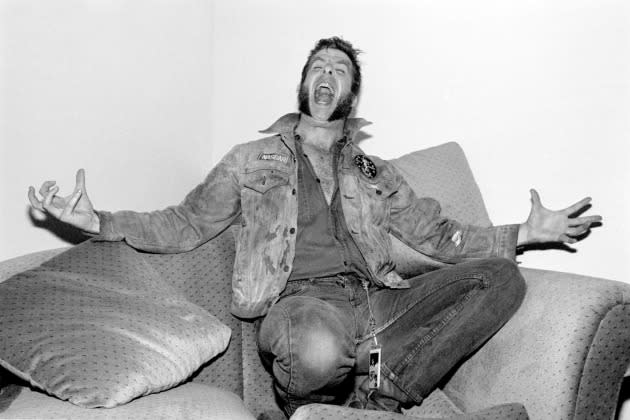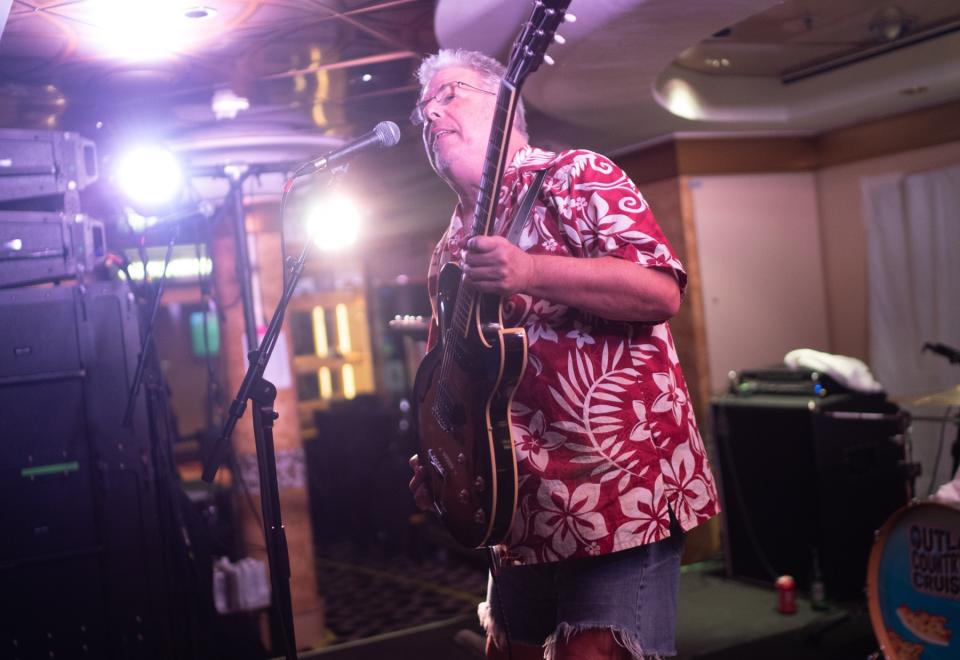Mojo Nixon Became a Cult Hero Singing About Anarchy, Sex, and Elvis. At 65, He Still Won’t Shut Up

It’s well after midnight somewhere off the coast of Florida, and Mojo Nixon is leading a cruise ship full of lubricated and rowdy country-music fans in a bawdy singalong of a song titled “Tie My Pecker to My Leg.”
We won’t get into the lyrics here, but the verses touch on everything from barnyard sex to fornicating at a county fair. “This guy just heard the song for the first time,” Nixon, 65, and dressed in his customary Hawaiian shirt and uneven denim cutoffs, says, pointing to a man in the front row. “He’s grinning ear to ear!”
More from Rolling Stone
Man Arrested, Protesters Clash at New York Attorney General Letitia James-Hosted 'Drag Story Hour'
Nandi Bushell Dedicates White Stripes Cover to 'Role Model' and 'Hero' Meg White
Team USA vs. Cuba Livestream: How to Watch the World Baseball Classic Semifinal Online
If there’s a safe space for Nixon and his unfiltered brand of worldly-redneck commentary and rambunctious cowpunk songs, it’s probably in international waters, free from any laws that may impede his ability to spout off. “It’s a real divider. If you can’t handle ‘Tie My Pecker to My Leg,’ you’re not gonna like the rest of the show,” Nixon says a few weeks later, back on dry land at his home in Cincinnati. “But if I don’t run a few people off, I haven’t done my job.”
Nixon, a shouting singer, button-pushing songwriter, unrepentant shit-stirrer and, since 2004, on-air personality for Sirius XM’s Outlaw Country channel — which is what finds him aboard the 2023 Outlaw Country Cruise — has been making a career out of both entertaining and appalling audiences since the early 1980s. That’s when he and washboard whiz Skid Roper formed a duo and began releasing songs like “Jesus at McDonald’s,” “Stuffin’ Martha’s Muffin,” and “Burn Down the Malls.”
His 1987 video for “Elvis Is Everywhere,” low on budget but big on go-karts and sideburns, made the 30-year-old Nixon a staple of the MTV era. Soon, he was performing the frenetic tribute to Elvis Presley’s die-hard fans on Arsenio Hall’s talk show, casting Winona Ryder in his music videos, and filming a series of promos for MTV in which he sang just-shy-of-dirty harmonica ditties and smashed television sets on a beach.
But around 1989, he and Roper (the Silent Bob to Nixon’s loquacious Jay) went their separate ways and Nixon set out on a solo career. That’s where The Mojo Manifesto: The Life and Times of Mojo Nixon, a new documentary now available to stream, picks up. Directed by Matt Eskey, the film opens with Nixon, riding high on a wave of what would today be called “viral” fame, entering a Memphis studio with producer Jim Dickinson to make his 1990 solo debut, Otis.
“That’s when things got really crazy. I wanted to have a band and I wanted to compete with the Replacements and the Blasters and Los Lobos,” Nixon tells Rolling Stone. With what he estimates to be a $100,000 budget, he hired Dickinson to produce, formed a “cowpunk supergroup” with friends like Country Dick Montana of the Beat Farmers and John Doe of X, and, to piss off the accountants, bought a go-kart with record-label money. “We wanted to have ‘go-kart’ in the budget. Some accountant with a green visor has to see it and go, ‘What the hell is this?’”
The go-kart tale, recounted in the movie by Nixon’s manager of 37 years, the chrome-domed “Bullethead,” is one of the highlights of The Mojo Manifesto, a long-in-the-works documentary that premiered last year at South by Southwest. At just 88 minutes, it somehow covers all the Mojo bases: his upbringing in Danville, Virginia, where he was born Neill Kirby McMillan Jr.; his “Road to Damascus” transformation into the Mojo Nixon character; his devotion to what he calls “raw, primitive rock & roll”; and his unexpected rise to, well, really just a cult hero. That’s as far as Nixon got.
He’s OK with that. “People dismiss me as a novelty artist, or, ‘Oh, he’s a cartoon.’ And that’s fine,” he says. “I don’t want to be taken seriously. I’m a cult artist.”
But every cult artist (or leader) has to have a doctrine. And Nixon’s is informed by free speech and expression. Not surprisingly for a man who once said, “I got a boner in Daytona’r” while hosting a live MTV spring-break special and sparred with Pat Buchanan on CNN, he abhors censorship and predicts this present moment of carefully watching language is temporary.
“We go through phases and this is just one of them,” he says, spelling out a credo that some may disagree with. “I firmly believe you can make fun of anything as long as your joke is funny. And I also believe that you can say anything, as long as you’re willing to suffer the consequences. We don’t need a thought police.”
The Mojo Manifesto echoes that point too. By using Nixon’s unconventional career as a barometer, it provides a tool for asking, “How far is too far?” For Nixon’s relationship with MTV, it was the song “Debbie Gibson Is Pregnant with My Two-Headed Love Child,” which they refused to play. For his relationship with the mainstream music business, it was one titled “Bring Me the Head of David Geffen.” According to Nixon, “That was the song where everybody in the music business said, ‘Hey, Mojo, this is funny, but I ain’t putting my name on it.’”

Ultimately, however, there was no lasting fallout for Nixon. To this day, he still gets paid to be Mojo Nixon, whether on satellite radio, on a boat, or, like at this week’s SXSW, on a stage. As Nixon says in The Mojo Manifesto, “Whatever line there is, we have crossed it and taken a shit on it.”
Best of Rolling Stone


